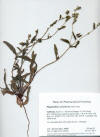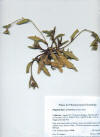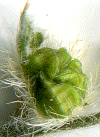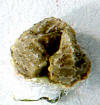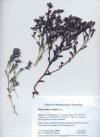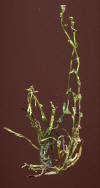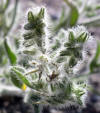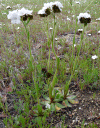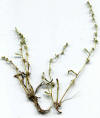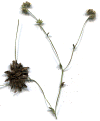|
The genus Plagiobothrys has a complicated taxonomic history as well
as being taxonomically complex. The identifications for the images
below are largely based on the treatment by T. C. Messick in the Jepson
Manual (1993, ed. Hickman); however, it should be noted that species
interpretations have varied from one flora to another. In Jepson, A Flora of California (Vol. 3, Pt.2, 1943), the genus Plagiobothrys was segregated from Greene's Allocarya (a later name for Macoya F. v. Muell) and Gray's Echidiocarya by the characters of leaves in a basal rosette and flowers entirely white. Allocarya, by contrast, differed in basal leaves not forming a rosette, and in the white flowers having a yellowish tube. Abrams (Illustrated Flora of the Pacific States, Vol. III, 1951) follows this treatment; however, the species were distinguished differently. Abrams (1951) initially segregated species of Allocarya by whether they are perennial (one species, P. mollis) or annual (28 species), and by whether they are "floriferous" to base (2 species, P. humistratus and P. scriptus). In later floras (Munz & Keck, A California Flora, 1959; Messick in Jepson Manual, ed., Hickman, 1993; Cronquist, A. Holmgren, N. Holmgren, Reveal & P. Homgren, Intermountain Flora, 1984), the species are all united under Plagiobothrys while also separated by their former generic differences, treated under different sections (sect. Echidiocarya, Plagiobothrys, Allocarya). A key character for recognizing sect. Allocarya is whether lower stem leaves are opposite (Munz 1959; Messick in Jepson Manual, 1993; R. B. Kelley, online Jepson Manual, 2nd ed). However, it appears that this distinction applies to species that have flowers above the base; that is also to say leaves appear opposite below the where the first flower appears (or sometimes where the first flower appears and below) and subsequently become reduced further up the stem—where also appearing alternate—as evident from illustrations in Abrams (1951), Cronquist et al. (1984) and images on CalPhotos. In some of the illustrations of species, especially where flowers are shown to develop to near the base of the plant (e.g., P. cognatus, P. humistratus, P. stipitatus), leaves appear entirely alternate. Consequently, other secondary characters such as flower color and habitat may be more helpful to identifying the species; however, Kelley (online Jepson Manual) indicates the yellow part of the flower may become white after pollination. Jepson (1943) commented in detail on the ornamentation of mericarps ("nutlets") having little taxonomic value. This was also recognized in the Jepson Manual (Messick 1993); for example, mericarps in some species are indicated in descriptions to be variable in the presence or absence of bristles. Kelley (online Jepson Manual, 2nd ed) further indicates that mature "nutlets" are required, and that not all "nutlets" are alike from the same flower, the one closest to the stem can be larger and more tightly attached than the other three, thus, also leaving a different scar. Furthermore, treatments of the individual species are not uniform. Abrams (1951) described A. humistratus as mostly prostrate but the illustration depicts an erect plant, whereas P. leptocladus similarly described ("prostrate") is shown to be decumbent, as also seen in the Jepson Manual and Intermountain Flora. Plagiobothrys scouleri in the Intermountain Flora includes P. cognatus, P. cusickii, and P. hispidulus that are recognized in the Jepson Manual as separate species. Additionally, Michael G. Simpson at San Diego State University is reportedly working on the nutty borages and his website [http://www.sci.sdsu.edu/plants/plagiobothrys/] has many excellent photos of Plagiobothrys nuts in addition to those by Steve Matson on CalPhotos.
|
|||
|
Plagiobothrys arizonicus |
Plagiobothrys arizonicus |
Plagiobothrys arizonicus
|
|
|
Plagiobothrys canescens |
Plagiobothrys hispida
|
|
|
|
Plagiobothrys
jonesii |
Plagiobothrys
kingii
var. harknessii
|
Plagiobothrys
nothofulvus
|
|
|
|
Plagiobothrys scouleri
complex |
||
|
Plagiobothrys tenellus
|
Plagiobothrys tenellus
|
||
|
Hartmann T., C. Theuring, T. Beuerle, L. Ernst, M. S. Singer and E. A. Bernays. 2004. Acquired and partially de novo synthesized pyrrolizidine alkaloids in two polyphagous arctiids and the alkaloid profiles of their larval food-plants. J. Chem. Ecol. 30(2): 229–254. “The profiles of pyrrolizidine alkaloids (PAs) in the two highly polyphagous arctiids Estigmene acrea and Grammia geneura and their potential PA sources in southeastern Arizona were compiled. One of four species of Boraginaceae, Plagiobothrys arizonicus, contained PAs; this is the first PA record for this plant species. The principle PA sources are Senecio longilobus (Asteraceae) and Crotalaria pumila (Fabaceae). The known PA pattern of S. longilobus was extended; the species was found to contain six closely related PAs of the senecionine type. Three novel PAs of the monocrotaline type, named pumilines A-C, were isolated and characterized from C. pumila, a species not studied before. The pumilines are the major PAs in the seeds, while in the vegetative organs they are accompanied by the simple necine derivatives supinidine and as the dominant compound subulacine (1beta,2beta-epoxytrachelanthamidine). In both plant species, the PAs are stored as N-oxides, except C. pumila seeds, which accumulate the free bases. Great variation in PA composition was observed between local populations of C. pumila. The PA profiles were established for larvae and adults of E. acrea that as larvae had fed on an artificial diet supplemented with crotalaria-powder and of G. geneura fed with S. longilobus. In both experiments, the larvae had a free choice between the respective PA source and diet or food plants free of PAs. The profiles compiled for the two species reflect the alkaloid profiles of their PA sources with one exception, subulacine could never be detected in E. acrea. Besides acquired PAs, insect PAs synthesized from acquired necine bases and necic acids of insect origin were detected in the two arctiid species. These insect PAs that do not occur in the larval food sources accounted for some 40-70% (E. acrea) and 17-37% (G. geneura) of total PAs extracted from the insects. A number of novel insect PAs were identified. Plant-acquired and insect PAs were found to accumulate as N-oxides. The results are discussed in relation to specific biochemical, electrophysiological, and behavioral mechanisms involved in PA sequestration by arctiids.” |
|||
